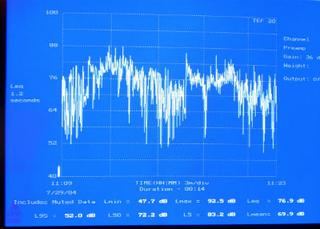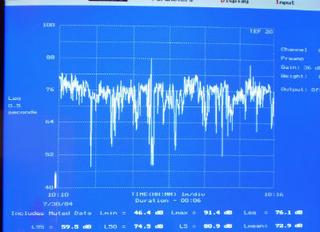Audio Levels: How Are We Doing?

Dave Moulton
As you may recall, we’ve been exploring the implications and effects of the CALM Act over the past year. We’ve considered what it means, how to approach it in production, the implications of compliance with B.S 1770 in our levels measurement and the nature of levels measurements.
This month, I decided to take another look at our current collective TV audio broadcast performance. This time I sampled 58 channels for C-weighted end-user levels, which I pulled apart into informal tiers of major network/cable presenters, cable variety presenters and cable movie bundles. I also noted whether my samples were program or commercials, and took a look at and listened to that variance.
Finally, I took two broadcast sequences: a movie and an NFL football game and edited them into all-program and all-commercial sequences, and made histograms of them. It was quite interesting, at least to a nerd like me.
WHAT I’VE MEASURED
Lmin
L95
Leq
L5
Lmax
Network tier
43.9
48.7
70.6
76.2
85.2
Variety tier
44.0
48.7
71.3
76.3
83.2
Movie tier
44.3
47.7
74.0
80.0
93.4
Max
44.3
48.7
74.0
80.0
93.4
Average
44.1
48.4
72.0
77.5
87.3
Min
43.9
47.7
70.6
76.2
83.2
Range
0.4
1.0
3.4
3.8
10.2
Table 1: C-weighted Levels of three tiers of channel bundles. Leq and L5 are probably the most important numbers here. These measurements were quite informal, and my studio is not presently “in” calibration due to some recent antics by my local power company, which wiped memory settings in my monitor speakers and my monitor control system. This means the absolute levels might not be quite what they should be, but the differences in level (which is what we are concerned with here) should be right on.
As before, my measurements are not B.S. 1770-1 compliant, for the same reasons that I described in an earlier column. For my findings, the effects of that negligence and sloth are insignificant.
Anyway, the results are quite encouraging.
OVERALL PROGRAM LEVELS
Fig. 1: Noise Level Analysis in dBC SPL of 14 minutes of movie soundtrack. Across 58 channels, C-weighted levels averaged 72.1 Leq with a maximum level of 79 dBC Leq and a minimum of 64 dBC Leq. While on the surface this doesn’t seem so good, the standard deviation was only 3.7 dB, which means that two-thirds of the channels were within a range of 3.7 dB, which is actually quite good.
Further, if we suspend outliers (movie credit fades, background music beds, as well as commercials, etc.) and consider only ongoing program material, the standard deviation shrinks to 1.4 dB, which is excellent.

COMMERCIAL LEVELS
Part of the impetus for the CALM Act came from the variation between program and commercial levels in succession. So I’ve spent some time studying that issue. Interestingly, in the group of major networks and cable presenters, the difference between program and commercial levels is now nominal (.7 dB); and the commercials were actually softer by a nominal amount.
Fig. 2: Noise Level Analysis in dBC SPL of 14 minutes of commercials taken from the same broadcast. For the cable “variety” group of channels, level consistency was not quite so good, with commercial levels being, on average, 4 dB above program levels. This will be noticeable and may annoy some listeners. However, it seems to me to be much better than it has been in the past.

MOVIES VS. NETWORKS VS.VARIETY-CABLE
Table 1 shows the overall levels I gathered for each of my informal tiers, based on one-minute samples for each channel. Just so you know, Lmin is the lowest level recorded in the file; L95 is the level exceeded 95 percent of the time; Leq is the power-based average of the entire file; L5 is the level exceeded 5 percent of the time; and Lmax is the highest level recorded in the file.
Note that the movie tier has a significantly wider dynamic range (which is as it should be, I think). The “network” tier and the “variety” tier are very similar, essentially identical on average.
COMMERCIALS VS. MOVIES ANDLIVE FEEDS
Fig. 3: Noise Level Analysis in dBC SPL of 6 minutes of live feed from an NFL broadcast. It gets quite interesting when we start directly comparing and measuring commercials vs. various programs. I recorded about an hour of a seven-year-old action film rerun on a cable channel with commercials (in the variety tier) and then carved it up in Pro Tools into assembled tracks of just sound track and just commercials. I made 14-minute histograms of each, and they are worth looking at. Fig. 1 shows what the sound-track (action film with rock-n-roll score) looked like.
Note the sizable and ongoing dynamic range, with numerous action peaks interspersed with softer dialogue sections.
Now consider the commercials that were taken from this same broadcast (see Fig.2). Note how tightly compressed the commercials are in comparison to the movie.
This is part of where audience annoyance comes from, I suspect, especially with the louder spots, which you can see pretty clearly. Lmax and L5 aren’t very different from the soundtrack, while Leq is up by 4 dB, and L95 is up by a whopping 12.5 dB.
Fig. 4: Noise Level Analysis in dBC SPL of 6 minutes of commercials from the same NFL broadcast It doesn’t have to be this way. Fig. 3 shows an NFL live broadcast cut up into six-minute segments of live feed and commercials. Note how tightly controlled and stable the levels are, including announcers, crowd noise, occasional music and referees’ live mics. Audio order from sonic chaos!
Now take a look at the commercials (Fig. 4). Take note of the very consistent and well-matched levels, as well as intentional use of soft levels and occasional peaks for dramatic effects. I suspect when you are making a commercial for a national ad buy for an NFL game you approach production and levels management differently than when you are producing spots for movie reruns. It sure looks that way here!


WHAT DOES IT ALL MEAN?
The news continues to be good on the CALM front. Levels are more consistent across the broad range of cable and network offerings I observed. Given that audio, in general, varies randomly over about a 10-decibel range just as a function of program, the levels I’ve measured here are certainly satisfactory. I’m also pleased that the movie bundle does have a wider range than the rest of the channels.
The tightly compressed audio of commercials, as measured in the rerun movie broadcast segment, is clearly audible and may be perceived as annoying simply because such compression leads to the subjective attribute I think of as “breathlessness that doesn’t stop,” which is tiring and often irritating to listen to. The fact that it is also up 4 dB Leq from the program makes it worse, of course. Compared to where we were three years ago, however, it is much better.
The proof of the pudding lies in the fact that I don’t need to change levels during surfing anymore. Occasionally I turn up a movie by 5 dB just to listen to what I think of as “producers’ levels,” but that’s it. No more constant tweaking of the remote, muttering imprecations or beginning to draft letters to congresspersons.
Good stuff. I’ll do a more formal update next February, replicating my measurements from 2011 and 2009, so stay tuned. Thanks for listening.
Dave Moulton is trying to be a nerd. However, that doesn’t mean you can’t still complain to him about almost anything at his website, www.moultonlabs.com.
Get the TV Tech Newsletter
The professional video industry's #1 source for news, trends and product and tech information. Sign up below.

